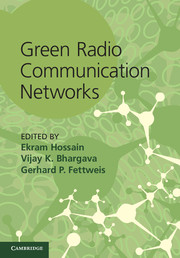Book contents
- Frontmatter
- Contents
- List of contributors
- Preface
- Part I Communication architectures and models for green radio networks
- Part II Physical communications techniques for green radio networks
- Part III Base station power-management techniques for green radio networks
- Part IV Wireless access techniques for green radio networks
- 12 Cross-layer design of adaptive packet scheduling for green radio networks
- 13 Energy-efficient relaying for cooperative cellular wireless networks
- 14 Energy performance in TDD-CDMA multi-hop cellular networks
- 15 Resource allocation for green communication in relay-based cellular networks
- Part V Green radio test-bed, experimental results, and standardization activities
- Index
- References
15 - Resource allocation for green communication in relay-based cellular networks
from Part IV - Wireless access techniques for green radio networks
Published online by Cambridge University Press: 05 August 2012
- Frontmatter
- Contents
- List of contributors
- Preface
- Part I Communication architectures and models for green radio networks
- Part II Physical communications techniques for green radio networks
- Part III Base station power-management techniques for green radio networks
- Part IV Wireless access techniques for green radio networks
- 12 Cross-layer design of adaptive packet scheduling for green radio networks
- 13 Energy-efficient relaying for cooperative cellular wireless networks
- 14 Energy performance in TDD-CDMA multi-hop cellular networks
- 15 Resource allocation for green communication in relay-based cellular networks
- Part V Green radio test-bed, experimental results, and standardization activities
- Index
- References
Summary
Introduction
The energy efficiency of wireless communication systems and their impact on the environment have been largely ignored in the past during the design and implementation of existing wireless networks. Increasing energy-consumption in these networks has been recently identified as a global problem due to its adverse effects on the environment and increasing cost of operation [1]–[5]. Cellular systems constitute a major part of wireless communications and their use in daily life is increasing more than ever [6]. Mobile devices are expected to surpass personal computers as the main web-accessing devices in the near future [7]. Therefore, mobile communications can contribute up to 15-20% of the overall energy-consumption in information and communication technologies (ICT) [7], which can no longer be disregarded.
The total energy-consumption of ICT itself is difficult to estimate because studies vary depending on the definition of ICT, the methodology used to generate the estimates, and the proportion of a device's energy consumption that is attributed to ICT [8, 9]. Several studies have suggested that the fraction of overall electricity consumption due to ICT infrastructure corresponded to around 7.8% in the European Union in 2005 [10], which is expected to rise to 10.9% by 2020. Around 3% of the world's electricity consumption is attributed to ICT, contributing to about 2% of worldwide CO2 emission [1, 9, 11, 12]. It is, therefore, apparent that there is an urgent need to design a sustainable cellular wireless communication system by developing energy-efficient (green) technologies.
Information
- Type
- Chapter
- Information
- Green Radio Communication Networks , pp. 331 - 356Publisher: Cambridge University PressPrint publication year: 2012
References
Accessibility standard: Unknown
Why this information is here
This section outlines the accessibility features of this content - including support for screen readers, full keyboard navigation and high-contrast display options. This may not be relevant for you.Accessibility Information
- 1
- Cited by
